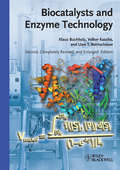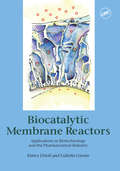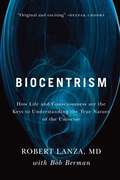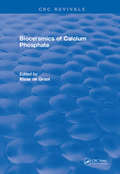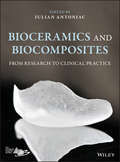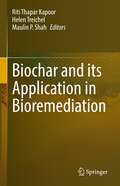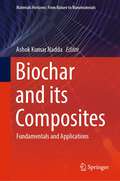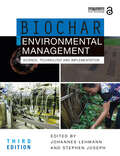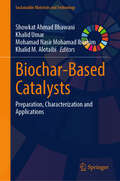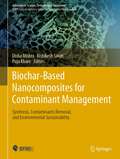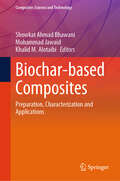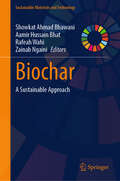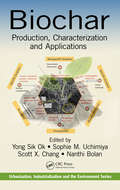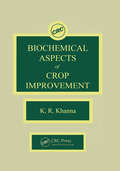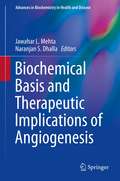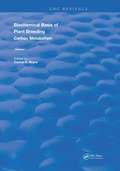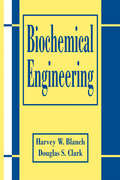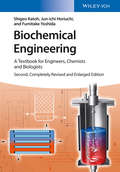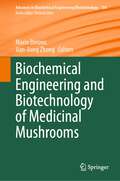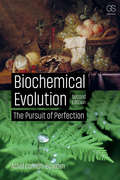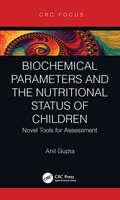- Table View
- List View
Biocatalysts and Enzyme Technology
by Klaus Buchholz Uwe Theo Bornscheuer Volker KascheThis second edition of a bestselling textbook offers an instructive and comprehensive overview of our current knowledge of biocatalysis and enzyme technology. The book now contains about 40% more printed content. Three chapters are completely new, while the others have been thoroughly updated, and a section with problems and solutions as well as new case studies have been added. Following an introduction to the history of enzyme applications, the text goes on to cover in depth enzyme mechanisms and kinetics, production, recovery, characterization and design by protein engineering. The authors treat a broad range of applications of soluble and immobilized biocatalysts, including wholecell systems, the use of non-aqueous reaction systems, applications in organic synthesis, bioreactor design and reaction engineering. Methods to estimate the sustainability, important internet resources and their evaluation, and legislation concerning the use of biocatalysts are also covered.
Biocatalytic Membrane Reactors: Applications In Biotechnology And The Pharmaceutical Industry
by Lidietta Giorno Enrico DrioliThis research level reference book has been co-written by Enrico Drioli, perhaps one of the world's best known researchers into membrane technology. The application of membrane technology to chemical transformation and molecular separation are beginning to be exploited in the pharmaceutical science and biotechnology industries, but there is a need for researchers and students to have up-to-date literature - and this book provides it. The book will be of interest to students of chemistry, chemical engineering, pharmacy and biotechnology.
Biocentrism: How Life and Consciousness are the Keys to Understanding the True Nature of the Universe
by Bob Berman Robert LanzaRobert Lanza is one of the most respected scientists in the world — a US News & World Report cover story called him a &“genius" and a &“renegade thinker," even likening him to Einstein. Lanza has teamed with Bob Berman, the most widely read astronomer in the world, to produce Biocentrism, a revolutionary new view of the universe. Every now and then a simple yet radical idea shakes the very foundations of knowledge. The startling discovery that the world was not flat challenged and ultimately changed the way people perceived themselves and their relationship with the world. For most humans of the 15th century, the notion of Earth as ball of rock was nonsense. The whole of Western, natural philosophy is undergoing a sea change again, increasingly being forced upon us by the experimental findings of quantum theory, and at the same time, towards doubt and uncertainty in the physical explanations of the universe's genesis and structure. Biocentrism completes this shift in worldview, turning the planet upside down again with the revolutionary view that life creates the universe instead of the other way around. In this paradigm, life is not an accidental byproduct of the laws of physics. Biocetnrism takes the reader on a seemingly improbable but ultimately inescapable journey through a foreign universe—our own—from the viewpoints of an acclaimed biologist and a leading astronomer. Switching perspective from physics to biology unlocks the cages in which Western science has unwittingly managed to confine itself. Biocentrism will shatter the reader's ideas of life--time and space, and even death. At the same time it will release us from the dull worldview of life being merely the activity of an admixture of carbon and a few other elements; it suggests the exhilarating possibility that life is fundamentally immortal. The 21st century is predicted to be the Century of Biology, a shift from the previous century dominated by physics. It seems fitting, then, to begin the century by turning the universe outside-in and unifying the foundations of science with a simple idea discovered by one of the leading life-scientists of our age. Biocentrism awakens in readers a new sense of possibility, and is full of so many shocking new perspectives that the reader will never see reality the same way again.
Bioceramics Calcium Phosphate
by K. de GrootThe first chapters are fundamental, in that the physical chemistry of calcium phosphate salts is discussed, along with mineralization (with emphasis on teeth) and remodelling of mineralized tissues. Thereafter follows a treatment of the influence of implants o surrounding hard tissues. This topic is followed by a chapter on preparation methods and biomechanical and biological aspects of calcium phosphate implants. In conclusion, two chapters are devoted to (possible) dental and medical applications. It is hoped that basic researchers can use the book in their efforts to improve this promising class of materials further, and that clinicians are inspired to define further possibilities and � at least as important � limitations.
Bioceramics and Biocomposites: From Research to Clinical Practice
by Iulian AntoniacProvides comprehensive coverage of the research into and clinical uses of bioceramics and biocomposites Developments related to bioceramics and biocomposites appear to be one the most dynamic areas in the field of biomaterials, with multiple applications in tissue engineering and medical devices. This book covers the basic science and engineering of bioceramics and biocomposites for applications in dentistry and orthopedics, as well as the state-of-the-art aspects of biofabrication techniques, tissue engineering, remodeling, and regeneration of bone tissue. It also provides insight into the use of bionanomaterials to create new functionalities when interfaced with biological molecules or structures. Featuring contributions from leading experts in the field, Bioceramics and Biocomposites: From Research to Use in Clinical Practice offers complete coverage of everything from extending the concept of hemopoietic and stromal niches, to the evolution of bioceramic-based scaffolds. It looks at perspectives on and trends in bioceramics in endodontics, and discusses the influence of newer biomaterials use on the structuring of the clinician’s attitude in dental practice or in orthopedic surgery. The book also covers such topics as biofabrication techniques for bioceramics and biocomposites; glass ceramics: calcium phosphate coatings; brain drug delivery bone substitutes; and much more. Presents the biggest trends in bioceramics and biocomposites relating to medical devices and tissue engineering products Systematically presents new information about bioceramics and biocomposites, developing diagnostics and improving treatments and their influence on the clinicians' approaches Describes how to use these biomaterials to create new functionalities when interfaced with biological molecules or structures Offers a range of applications in clinical practice, including bone tissue engineering, remodeling, and regeneration Delineates essential requirements for resorbable bioceramics Discusses clinical results obtained in dental and orthopedic applications Bioceramics and Biocomposites: From Research to Use in Clinical Practice is an excellent resource for biomaterials scientists and engineers, bioengineers, materials scientists, and engineers. It will also benefit mechanical engineers and biochemists who work with biomaterials scientists.
Biochar Applications in Agriculture and Environment Management
by Jay Shankar Singh Chhatarpal SinghThis book provides up-to-date information on biochar use in management of soil health, agriculture productivity, green-house gases, restoration ecology and environment. Biochar application to nutrient deficient and disturbed soils is a viable option which may promotes advances in food safety and food security to human nutrition and overall fundamental research in the agricultural sciences. The book describes in detail how the recalcitrant biochar is able to persist for long periods of time and work as a shelter for soil microbial colonisation and their biomass/numbers. This book also includes contents related to important role of biochar applications in the restoration of contaminated agricultural soils. The book will be of particular interest to students, teachers and researchers in the disciplines.
Biochar and its Application in Bioremediation
by Helen Treichel Maulin P. Shah Riti Thapar KapoorBiochar prepared from agricultural biomass has received considerable attention because of the huge availability of ago-waste at zero cost, flexibility, high efficiency, renewability, faster contaminant removal rate, ability to treat concentrated effluent and reduction of sludge production after the treatment. This book on biochar is a comprehensive account of preparation of biochar from agricultural waste. It provides a roadmap in development of future strategy for pollution abatement and sustainable waste management. This book contains up-to-date information on biochar and its role in environment protection. The book covers useful information and applications of biochar to research scholars, academicians, agronomists, scientists and environmentalist working in the field of environment protection, bioremediation, waste management and climate change mitigation.
Biochar and its Composites: Fundamentals and Applications (Materials Horizons: From Nature to Nanomaterials)
by Ashok Kumar NaddaThe book discusses the commercial applications of biochar and its composites. Biochar prepared from pyrolysis of waste biomass is gaining widespread attention in environmental remediation due to its multifaceted benefits. This book explores these possible applications of biochar in water treatment and removal of pollutants from the contaminated sites. It also emphasizes the role of biochar engineering through different physical and chemical methods to enhance structural and physicochemical properties of biochar such as surface area, porosity and surface functional group. It also focuses on the diverse source of biomass that can be used for biochar production, different methodologies for biochar preparation and biochar engineering for improvement of its properties. Finally, it describes all the applications of biochar that can contribute to environmental remediation and sustainability. Given the contents, the book will be useful for students, researchers and professionals in the area of environmental chemistry and material science.
Biochar for Environmental Management: Science, Technology and Implementation
by Stephen JosephFully revised and updated for its third edition, this book presents the definitive compilation of current knowledge on all aspects of biochar.Research on biochar continues to accelerate as its importance for soil health, climate change mitigation and adoption, and the circular economy becomes more widely acknowledged. This book not only reviews recent advances made in our understanding of biochar properties, behavior, and effects in agriculture, environmental management, and material production, but specifically develops fundamental principles and frameworks of biochar science and application. This third edition has been fully revised and updated to reflect recent developments and growing trends, with important coverage of the application of biochar outside of its traditional soil-based uses, the commercialization of biochar, and its incorporation into policy. This includes brand new chapters on the role of biochar-based materials for environmental remediation, building construction, and animal feed, and a greater discussion of biochar's role in the circular economy, climate change mitigation, and sustainable development. Overall, this book provides a systematic, comprehensive, and global examination of biochar. Written by an international team of academics and professionals, it addresses its uses, production, and management and its broader potential for mitigating climate change and driving forward sustainable development.Edited by two leading figures in the field, Biochar for Environmental Management is essential reading for students, scholars, practitioners, and policymakers interested in biochar and the role it can play in environmental sustainability and global sustainable development.Chapter 16 of this book is freely available as a downloadable Open Access PDF at http://www.taylorfrancis.com under a Creative Commons Attribution-Non Commercial-No Derivatives (CC-BY-NC-ND) 4.0 license.
Biochar-Based Catalysts: Preparation, Characterization and Applications (Sustainable Materials and Technology)
by Mohamad Nasir Mohamad Ibrahim Showkat Ahmad Bhawani Khalid Umar Khalid M. AlotaibiThis book reviews comprehensively the field and development of biochar-based catalyst by summarizing fundamental approaches and principles to prepare biochar and biochar-based catalysts and focusing on the main applications of biochar-based catalysts in environmental remediation. Biochar is a low-cost carbonaceous material produced from biomass and is regarded as an economical substitute to the activated carbon. The coverage of book highlights the most exciting applications of biochar-based catalysts in different reactions such as oxidation, reduction, hydrolysis, isomerization, dehydration, etc. The book is useful for the academics and researchers who are interested in the development biochar-based catalysts with background in material science, chemical engineering, environmental engineering and environmental chemistry.
Biochar-Based Nanocomposites for Contaminant Management: Synthesis, Contaminants Removal, and Environmental Sustainability (Advances in Science, Technology & Innovation)
by Rishikesh Singh Disha Mishra Puja KhareThis book helps the readers get a holistic understanding of the emergence of biochar-nanocomposite research. The low and long-term exposure of persistent hazardous pollutants in environment is well known for damaging the water, soil, sediments, and living biota. Thus, it is a crucial step to eliminate these pollutants from environment regimes to prevent the on-site destruction or the transfer into the food chain. Biochar is a carbon-rich solid material generated through pyrolysis of biomass, and currently, it is covering the hotspot in environmental management of pollutants. It is being utilized for the efficient immobilization and sorption of organic pollutants, heavy metals, dyes, improvement of soil redox conditions, aggregate stabilization, photocatalytic degradation, and for carbon sequestration. The fascinating properties like surface area, porous structures, functional groups, and mineral components turn it into suitable candidate for the removal of various class of pollutants from environmental matrices. Different reactions like sorption, reduction, precipitation, solidification, and degradation are mainly responsible for the effective cleaning of xenobiotics from environment through biochar application. However, rapidly evolving contaminants in the environment have made the remediation more complex, expensive, and challenging. In view of these aspects, the modification of biochar through the doping of nanometals/metal oxides/surfactants/ or chemical entities will result in modified biochar with high surface area, more functional entities, improved physical, chemical, thermal, and mechanical characteristics with more adsorptive sites. Inclusion of these exclusive properties can be done through magnetic modification, impregnation of nanometals/ metal oxides/surfactants, amination, acid/base reactions, steam activation, etc. The resulted biochar-based nanocomposites have demonstrated a vital role in remediation of persistent organic pollutants, radionuclei, and heavy metals through the various interaction mechanisms like surface complexation, π–π interaction, electrostatic interaction, hydrogen bonding, Fenton process, and photocatalytic degradation. Currently, advanced research work has been carried out for the designing of modified composites of biochar to achieve maximum removal efficiency, reusability, biotoxicity, and sustainability. Hence, for selective removal of pollutants through designed biochar surface with the focused experimentation toward optimization of feedstocks, process variables, appropriate impregnation of nanomaterials, interaction with secondary pollutants, physical environment, longevity, and regeneration will definitely pave the way for safe and commercial application of biochar-based nanocomposites.
Biochar-based Composites: Preparation, Characterization and Applications (Composites Science and Technology)
by Mohammad Jawaid Showkat Ahmad Bhawani Khalid M. AlotaibiThis book provides solid, quantitative descriptions and reliable guidelines, reflecting the maturation and demand of the field and the development of biochar-based composites. This book summarizes the fundamental approaches and principles to prepare biochar-based composites. This book focuses on some important materials (metal oxide/hydroxide, magnetic, clay minerals, graphene oxide, etc.) used for the production of the composites. The coverage of book highlights the most exciting applications of biochar-based composites in the removal of organic and inorganic contaminants from waste water. The book is useful for the academics and researchers who are interested in the development biochar-based composites with background in material science, chemical engineering, environmental engineering and environmental chemistry.
Biochar: A Sustainable Approach (Sustainable Materials and Technology)
by Aamir Hussain Bhat Rafeah Wahi Showkat Ahmad Bhawani Zainab NgainiThis book highlights the latest research on biochar, a low-cost carbonaceous material produced from biomass, and is regarded as an economical substitute to the activated carbon. The book describes the production and the characteristics of biochar through various techniques/methods such as pyrolysis, gasification, torrefaction, and hydrothermal carbonization of carbonaceous biomass, such as agricultural residues, algal biomass, forest residues, manures, activated sludge, energy crops, digestate at high temperature (300–900 °C) and under O2-limiting conditions. The book also highlights the several unique properties of biochar such as an efficient, cost-effective, and environmentally-friendly material for diverse contaminants removal. The variability in physicochemical properties (e.g., surface area, micro-porosity, and pH) provides an avenue for biochar to maximize its efficacy to targeted applications. This book interests academics working in the development of green and sustainable technology in agricultural engineering, material science, chemical engineering, and environmental science.
Biochar: Production, Characterization, and Applications (Urbanization, Industrialization, and the Environment)
by Sophie M. Uchimiya Scott X. Chang Nanthi Bolan Yong Sik OkEncompassing high priority research areas such as bioenergy production, global warming mitigation, and sustainable agriculture, biochar has received increased worldwide interest in the past decade.Biochar: Production, Characterization, and Applications covers the fundamentals of biochar including its concept, production technology, and characteriza
Biochemical Applications of Nonlinear Optical Spectroscopy (Optical Science and Engineering)
by Vladislav V. YakovlevFor a host of reasons, nonlinear optical spectroscopy is a valuable tool for biochemical applications where minimally invasive diagnostics is desired. Biochemical Applications of Nonlinear Optical Spectroscopy presents the latest technological advances and offers a perspective on future directions in this important field.Written by an international panel of experts, this volume begins with a comparison of nonlinear optical spectroscopy and x-ray crystallography. The text examines the use of multiphoton fluorescence to study chemical phenomena in the skin, the use of nonlinear optics to enhance traditional optical spectroscopy, and the multimodal approach, which incorporates several spectroscopic techniques in one instrument. Later chapters explore Raman microscopy, third-harmonic generation microscopy, and non-linear Raman microspectroscopy. The text explores the promise of beam shaping and the use of broadband laser pulse generated through continuum generation and an optical pulse shaper.Lastly, the book discusses the effects of spatial beam shaping on the generated nonlinear Raman signals in a tightly focused geometry and provides insight into the extension of nonlinear optical spectroscopy to the nanoscale through the use of plasmonic tip-enhanced arrangement. With novel experimental approaches to this technology expanding day-by-day, the book’s balanced coverage from a wide range of international contributors not only elucidates important achievements, but also outlines future directions in this dynamic and promising field.
Biochemical Aspects of Crop Improvement
by K. R. KhannaThis book provides a comprehensive review at the biochemical and molecular level of the processes and techniques that contribute to crop improvement. General topics include a historical perspective of the advancements in crop improvement; cultivar systematics and biochemical and molecular markers in crop improvement programs; the genetics of physiological and biochemical processes affecting crop yield; the genetics of photosynthesis, chloroplast, relevant enzymes, and mutations; osmoregulation/adjustment and the production of protective compounds in relation to drought tolerance; and the biochemistry of disease resistance, including elicitors, defense response genes, their role in the production of phytoalexins and other strategies against pathogens. Other topics include quality breeding (e.g., molecular gene structure, changing individual amino acids, enhancing nutritive value of proteins) and biotechnology/genetic engineering. Geneticists, biochemists, botanists, agricultural specialists and others involved in crop improvement and breeding should consider this volume essential reading.
Biochemical Basis and Therapeutic Implications of Angiogenesis (Advances in Biochemistry in Health and Disease #6)
by Naranjan S. Dhalla Jawahar L. MehtaAngiogenesis is a highly complex phenomenon where new blood vessels are formed for the supply of oxygen and nutrients in different organs of the body. It plays a critical role in both physiological processes such as growth and development as well as pathological processes including cancer and different types of tumors. Angiogenesis is also essential for the regeneration and survival of cells in several disease conditions such as ischemic heart disease (myocardial infarction), atherosclerosis, brain injury (stroke) and diabetes. Since the mechanisms of angiogenesis are organ specific and differ among various diseases, it is proposed to devote one section of this book to the development of angiogenesis in some selected diseases such as cancer, ischemic heart disease, atherosclerosis, diabetes and stroke. It is pointed out that extensive research work in this regard has been carried out in the area of cancer and heart disease, whereas relatively less attention has been paid to studying angiogenesis in other disease conditions.
Biochemical Basis of Plant Breeding: Volume 1 Carbon Metabolism (Routledge Revivals)
by Carlos A. NeyraFirst published in 1985: This book presents a comprehensive survey of progress and current knowledge of those biochemical processes with greater potential for the development of superior cultivars: Photosynthesis, photorespiration, nitrate assimilation, biological nitrogen fixation, and starch and protein synthesis.
Biochemical Engineering
by Douglas S. Clark Harvey W. BlanchThis work provides comprehensive coverage of modern biochemical engineering, detailing the basic concepts underlying the behaviour of bioprocesses as well as advances in bioprocess and biochemical engineering science. It includes discussions of topics such as enzyme kinetics and biocatalysis, microbial growth and product formation, bioreactor design, transport in bioreactors, bioproduct recovery and bioprocess economics and design. A solutions manual is available to instructors only.
Biochemical Engineering
by Shigeo Katoh Fumitake Yoshida Jun-Ichi HoriuchiCompletely revised, updated, and enlarged, this second edition now contains a subchapter on biorecognition assays, plus a chapter on bioprocess control added by the new co-author Jun-ichi Horiuchi, who is one of the leading experts in the field. The central theme of the textbook remains the application of chemical engineering principles to biological processes in general, demonstrating how a chemical engineer would address and solve problems. To create a logical and clear structure, the book is divided into three parts. The first deals with the basic concepts and principles of chemical engineering and can be read by those students with no prior knowledge of chemical engineering. The second part focuses on process aspects, such as heat and mass transfer, bioreactors, and separation methods. Finally, the third section describes practical aspects, including medical device production, downstream operations, and fermenter engineering. More than 40 exemplary solved exercises facilitate understanding of the complex engineering background, while self-study is supported by the inclusion of over 80 exercises at the end of each chapter, which are supplemented by the corresponding solutions. An excellent, comprehensive introduction to the principles of biochemical engineering.
Biochemical Engineering and Biotechnology of Medicinal Mushrooms (Advances in Biochemical Engineering/Biotechnology #184)
by Jian-Jiang Zhong Marin BerovicThis book offers a comprehensive review of the latest developments in medicinal mushroom biochemical engineering and biotechnology, and it also analyses the circular economy of mushroom bioproduction. Divided into 13 chapters, the book begins with a historical perspective of medicinal mushrooms, followed by authoritative chapters that explore the farming of medicinal mushrooms and bioeconomy, as well as the limitations of using medicinal mushrooms to produce metabolites. Subsequent chapters cover topics such as solid-state and submerged cultivation of medicinal mushroom mycelia in bioreactors, pilot and industrial bioreactor cultivation experiences, downstream processing of medicinal mushroom products, and biochemistry of medicinal mushroom bioactive compounds. Particular attention is given to the recent genetic engineering techniques applied in mushroom cultivation. The book closes with a chapter devoted to the health and clinical benefits of medicinal fungi, where readers will find expert insights into the therapeutic implications of medicinal fungi. In this book, readers will find an authoritative perspective on the past, present and future of medicinal mushrooms, and will also learn about some recent clinical studies with isolates from these natural products. Given its breadth, this book will appeal to biotechnologists working in mushroom cultivation, as well as to professionals interested in traditional pharmacy and medicine.
Biochemical Evolution: The Pursuit of Perfection
by Athel Cornish-BowdenBiochemical Evolution: The Pursuit of Perfection, Second Edition describes the relationship between biochemistry and evolutionary biology, arguing that each depends on the other to be properly understood.
Biochemical Mechanisms for Metabolic Syndrome (Advances in Biochemistry in Health and Disease #31)
by Anita Mehta Tejal GandhiThe book "Biochemical Mechanisms for Metabolic Syndrome" delves into the intricate biochemistry underlying the complex condition known as Metabolic Syndrome. The main focus of the book is to provide a comprehensive overview and in-depth exploration of the various biochemical processes and molecular mechanisms contributing to the development and progression of Metabolic Syndrome. The book is structured into several chapters, each with a specific purpose. The initial chapters, lay the groundwork by introducing the concept of Metabolic Syndrome, its historical context, prevalence, and the risk factors associated with it. Subsequent chapters tackle various aspects of insulin resistance and its underlying mechanisms, lipid metabolism dysregulation, the impact of obesity, and the complex interplay between Metabolic Syndrome and hypertension. The book then shifts focus to exploring the genetic predisposition to Metabolic Syndrome and delves into recently explored indepth cellular and tissue mechanisms, including the role of gut barrier dysfunction and adipose tissue remodeling. Chapters dedicated to molecular mechanisms and signaling pathways offer a deeper understanding of the inflammatory resolution, and endoplasmic reticulum stress in the context of Metabolic Syndrome. Another significant aspect of the book is the exploration of the Brain-Gut-Adipose Axis and endocrine regulation, looking at the impact of gut microbiota-derived metabolites, gut hormones, and neuronal regulation on Metabolic Syndrome. Additionally, omics technologies are covered extensively, ranging from genomics, transcriptomics, proteomics, and epigenomics, to unravel the molecular complexity of Metabolic Syndrome. The latter part of the book delves into therapeutic approaches, including lifestyle interventions, pharmacological interventions, and dietary strategies. It also explores the therapeutic potential of brown adipose tissue, and highlights future directions and emerging research in the field of Metabolic Syndrome biochemistry. Overall, the book will provide a valuable resource for researchers, healthcare professionals, and students seeking a comprehensive understanding of the biochemical intricacies of Metabolic Syndrome and potential avenues for therapeutic interventions.
Biochemical Parameters and the Nutritional Status of Children: Novel Tools for Assessment
by Anil GuptaBiochemical parameters represent better, precise, and objective tools toward the assessment of the nutritional status of children in comparison to anthropometric, clinical, and dietary methods. They constitute laboratory tests to estimate the concentration of circulating nutrients in body fluids. Biochemical parameters are suggestive of acute or subclinical conditions when other methods of nutritional assessment fail to interpret the condition. These parameters exhibit substantial variability in their reproducibility. Moreover, these parameters are novel tools in the hands of clinicians for screening of the nutritional status of children. Key Features Covers the latest biochemical parameters for nutritional assessment Updated content is useful for clinicians, nutritionists, and general practitioners A unique and concise treatise covering descriptive and research-based work on a crucial health issue of worldwide prevalence About the Author Anil Gupta, PhD, is the Dean of Research at Desh Bhagat University and Professor and Head, Department of Physiology and Biochemistry at Desh Bhagat Dental College and Hospital, Mandi Gobindgarh, Punjab, India.
Biochemical Pathways
by Dietmar Schomburg Gerhard MichalThe pathways and networks underlying biological functionNow in its second edition, Biochemical Pathways continues to garner praise from students, instructors, and researchers for its clear, full-color illustrations of the pathways and networks that determine biological function.Biochemical Pathways examines the biochemistry of bacteria, plants, and animals. It offers a quick overview of the metabolic sequences in biochemical pathways, the chemistry and enzymology of conversions, the regulation of turnover, the expression of genes, the immunological interactions, and the metabolic background of health disorders. A standard set of conventions is used in all illustrations, enabling readers to easily gather information and compare the key elements of different biochemical pathways. For both quick and in-depth understanding, the book uses a combination of:Illustrations integrating many different features of the reactions and their interrelationshipsTables listing the important system components and their functionText supplementing and expanding on the illustrated factsIn the second edition, the volume has been expanded by 50 percent. Text and figures have undergone a thorough revision and update, reflecting the tremendous progress in biochemical knowledge in recent years. A guide to the relevant biochemical databases facilitates access to the extensive documentation of scientific knowledge.Biochemical Pathways, Second Edition is recommended for all students and researchers in such fields as biochemistry, molecular biology, medicine, organic chemistry, and pharmacology. The book's illustrated pathways aids the reader in understanding the complex set of biochemical reactions that occur in biological systems.From the reviews:"... highly recommended for every scientist and student working in biochemistry." -Umwelt & Gesundheit 4/2012 (review in German language)
